After the conclusion of the 5G frequency auction and other relevant bands at the end of 2021, it is important to provide a first overview of the development observed in the next generation mobile networks, known as 5G.
As regards the number of base stations already installed in the national territory with 5G technology, the total number, according to information reported to ANACOM by the end of the 1st half of 2022, amounts to 2918 stations spread across 198 municipalities (64% of municipalities in the country) and 859 civil parishes (28% of civil parishes in the country).
Figure 1 - Municipalities with 5G stations
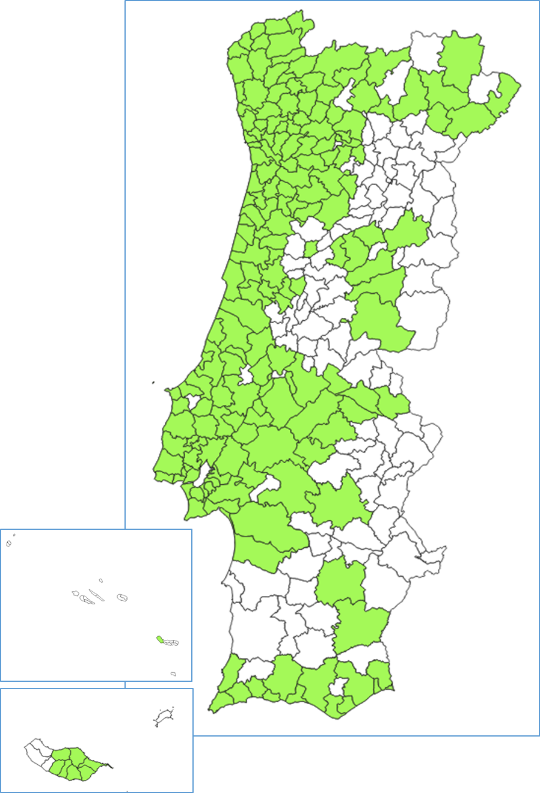
So far, NOS is the operator that has installed the largest number of 5G stations, 1937 stations (66%), followed by Vodafone with 534 stations (18%) and MEO with 447 stations (15%).
Despite this evolution, taking into account the total number of existing stations (2G, 3G, 4G and 5G), NOS is the operator with the lowest number of stations, amounting to 10 267 (27% of the total), Vodafone ranking first with 14 684 stations (38%), and MEO second with 13 779 stations (36%).
Figure 2 - Number of 2G, 3G, 4G and 5G stations per operator
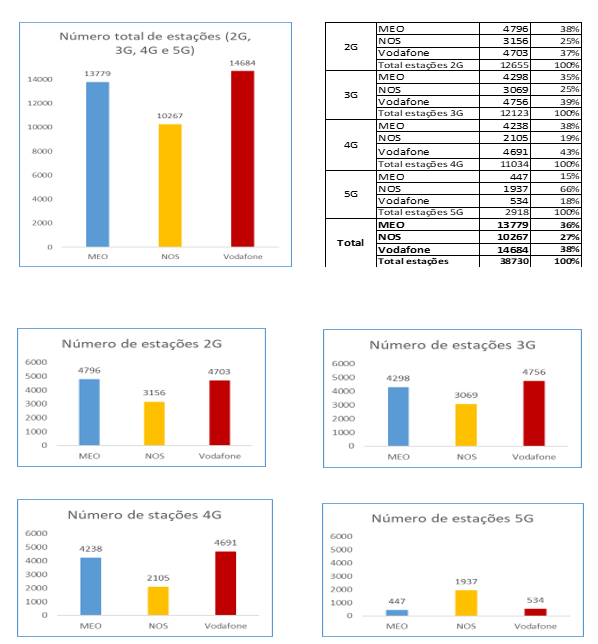
It should be noted that many of each operator’s 2G, 3G, 4G and 5G stations are located in the same place, so it is important to analyse the total number of sites where each operator has stations. Thus, it is observed that Vodafone has stations in 5 019 locations, MEO in 4 883 locations and NOS in 3 553 locations.
Figure 3 - Number of sites with stations per operator
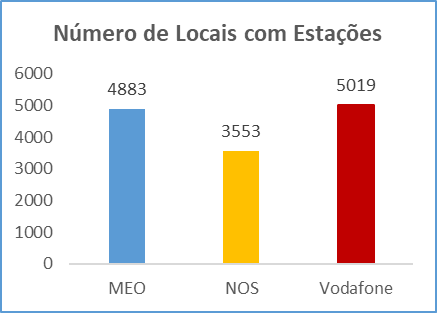
The vast majority of 5G stations, 79% of the total, corresponding to 2 316 stations, is located in Predominantly Urban Areas. Only 11% (325 stations) are installed in Medium Urban Areas and 10% (277 stations) in Predominantly Rural Areas.
Figure 4 - Number of 5G stations per category of urban and rural areas
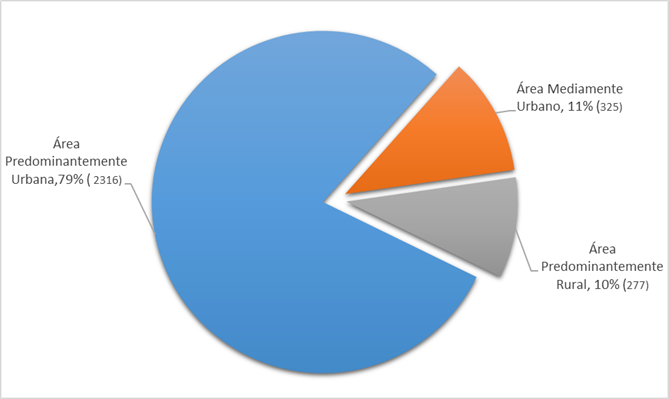
The analysis of the distribution of 5G stations across the country’s civil parishes, taking into account their population density, leads to the conclusion that only 13% of the total (372 stations) are installed in low density civil parishes.
Figure 5 - Distribution of 5G stations per type of civil parish
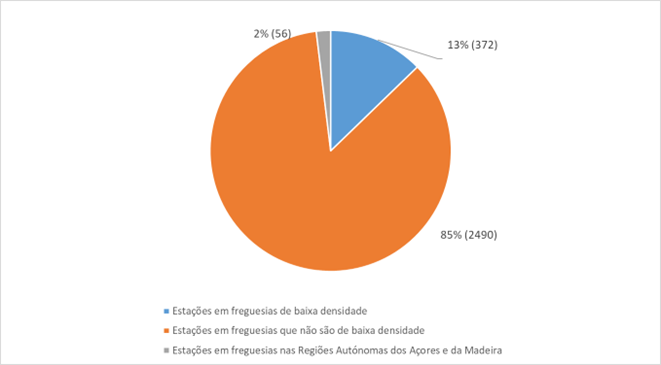
Although the vast majority of 5G stations is installed in non-low density civil parishes, only about half of these civil parishes already have 5G stations.
Figure 6 - Non-low density civil parishes with and without 5G stations
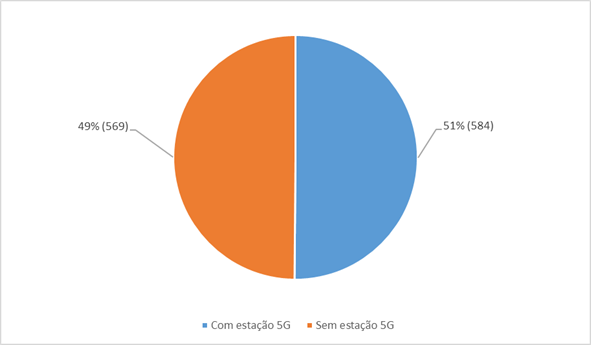
In the case of low density civil parishes, the large majority still lacks 5G stations, 86% of the total (1479 civil parishes). Only 14% of the total (250 civil parishes) are already provided with 5G stations.
Also in the case of civil parishes of the Autonomous Regions of the Azores and Madeira, there is a very high proportion of those which do not have 5G stations, 88% of the total, i.e. 185 parishes. Only 25 parishes (12%) are already equipped with 5G stations.
Figure 7 - Low density civil parishes with and without 5G stations
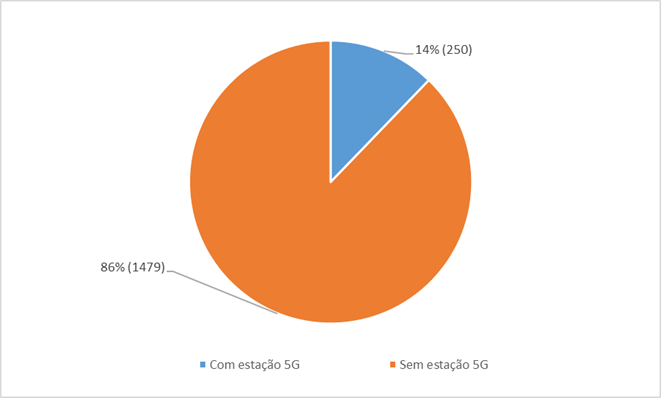
Figure 8 – Civil parishes of the Autonomous Regions of Azores and Madeira with and without 5G stations
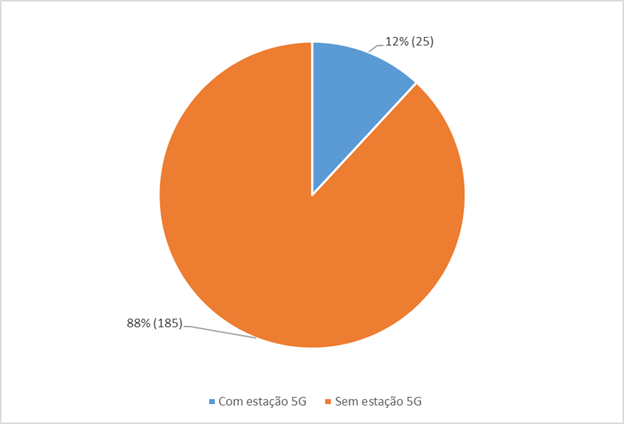
According to the available information, it is estimated that by the end of May, traffic carried on 5G networks represents around 5.3% of total mobile data traffic.
With the purpose of better characterising the 5G situation in the country, ANACOM carried out a wide range of measurements in all municipalities across the national territory, including the Autonomous Regions. Measurements, made with the NET.mede app, took place for the most part near the town halls of each municipality, with some additional tests having also been made while travelling. In total, 1682 tests were carried out between May and June in which the equipment’s operating system indicated the presence of 5G.
Figure 9 - Average values observed in all 5G tests
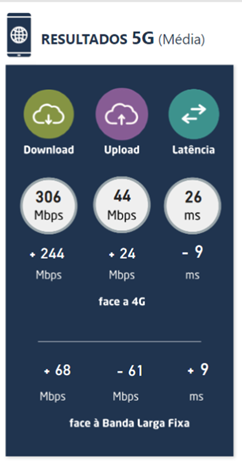
The average value of these tests carried out all over the country, in terms of download speed, was 306 Mbps, i.e. a value 244 Mbps higher than the one observed in 4G tests and 68 Mbps higher than the one observed in fixed Broadband tests. In the case of fixed Broadband, the value from the NET.mede report for the 1st quarter of this year was taken into account.
In terms of upload speed an average value of 44 Mbps was observed, that is, a value 24 Mbps higher than the one observed in 4G tests, but 61 Mbps lower than the one observed in fixed broadband tests.
The average value in terms of latency was 26 ms, 9 ms less than in 4G tests, but 9 ms more than in Fixed Broadband tests.
The best results in terms of download speed (average value of the tests) were observed in the municipality of Estarreja, with 871 Mbps; followed by the municipality of Moita, with 715 Mbps; and Vizela, with 690 Mbps.
|
Ranking |
Municipality |
Download speed |
|
1 |
Estarreja |
871 |
|
2 |
Moita |
715 |
|
3 |
Vizela |
690 |
|
4 |
Evora |
686 |
|
5 |
Pombal |
683 |
|
6 |
Povoa de Varzim |
676 |
|
7 |
Albufeira |
665 |
|
8 |
Leiria |
659 |
|
9 |
Vila Real |
651 |
|
10 |
Faro |
636 |
In terms of upload speed, the best result, 127 Mbps, was also recorded in the municipality of Estarreja; the second best performance was observed in the municipalities of Portimão and Caminha, with 111 Mbps.
|
Ranking |
Municipality |
Download speed |
|
1 |
Estarreja |
127 |
|
2 |
Portimao |
111 |
|
3 |
Caminha |
111 |
|
4 |
Chamusca |
110 |
|
5 |
Albufeira |
102 |
|
6 |
Miranda do Corvo |
93 |
|
7 |
Almada |
82 |
|
8 |
Cartaxo |
86 |
|
9 |
Mirandela |
85 |
|
10 |
Castro Marim |
84 |
As regards latency, the best results in terms of lower latencies were achieved in Almeirim, with 13.8 ms; followed by Torres Novas, with 14.3 ms; and Santarem with 14.5 ms.
|
Ranking |
Municipality |
Latency |
|
1 |
Almeirim |
13.8 |
|
2 |
Torres Novas |
14.3 |
|
3 |
Santarem |
14.5 |
|
4 |
Marinha Grande |
14.8 |
|
5 |
Miranda do Corvo |
15.0 |
|
6 |
Tomar |
15.0 |
|
7 |
Sesimbra |
15.1 |
|
8 |
Batalha |
15.2 |
|
9 |
Santa Comba Dao |
15.2 |
|
10 |
Torres Vedras |
15.3 |
According to the 5G tests carried out, there are quite uneven situations regarding the characteristics of the access to 5G available in the municipalities of the country that already have stations.
This information exclusively reflects the tests carried out and is not representative of the wide range of users in each region.
It should be noted that the information now disclosed is not enough on its own to assess compliance with coverage or network development obligations imposed on operators who acquired spectrum at the auction.




